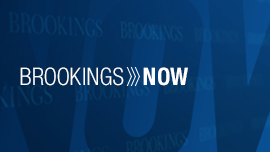How is counterinsurgency like the way the human body fights disease? In “The Health of Nations,” Stanley McChrystal, former commander of U.S. forces in Afghanistan and now a senior fellow at Yale University, and Kristina Talbert-Slagle, an associate research scientist at Yale Global Health Leadership Institute, presented their model of counterinsurgency warfare that likens that mission to the way in which the human body fights infectious disease in an event today sponsored by the Center for 21st Century Security and Intelligence.
Gen. McChrystal and Dr. Talbert-Slagle engaged the audience in a fascinating parallel discussion of infectious disease and how the body fights it, and insurgency in weak states. The event was moderated by Senior Fellow Michael O’Hanlon, who emphasized that this was “not meant to be … what to do next in Afghanistan” or other world trouble spots, but “a more general consideration of the nature of counterinsurgency and looking to gain insights … by this aspect of human immunology and physiology.”
Gen. McChrystal and Dr. Talbert-Slagle have been collaborating on this concept for the previous couple of years, since she started thinking about the connections between the human immune system and how it may be similar to counterinsurgency. After Gen. McChrystal came to Yale, the two met and began working on the concepts together.
Gen. McChrystal called the nation-state a “living organism that depends on certain things to work,” including metrics around the economy, education, employment, property rights and a free press.
We’ve got a lot of history in dealing with problems that weren’t exactly like normal conventional war. And typically what you find is you have a sick nation, a nation with a problem. It’s infected and I use the term very carefully here with an insurgency. It has developed a disease that it has to deal with. But what’s the real problem?
Dr. Talbert-Slagle walked the audience through the basics of infection and the human immune system that responds to and fights it. “An infection inside of a human body is really an attempt by a small group of microorganisms to take hold and spread,” she said, but are “outmaneuvered” by the body’s defenses. Most people are subject to constant exposure to possible infections—tens of thousands of microorganisms every day—yet most of us are healthy (she noted that probably 90% of the people in the audience had Epstein-Barr virus in their bodies, for example).
“Human bodies aren’t the only things that get infected,” Gen. McChrystal said. “If you think in terms of a nation, even our own, you can have infections, and we’ll call it insurgency here, that are threats to a nation” but most nations can fend them off or don’t notice them, in the same way that a person doesn’t notice most infections. “We are exposed a lot,” he said, pointing out the estimated 300 anti-government militias in the U.S. right now. “But we typically don’t feel as though we are threatened by an insurgency on any given date.”
Most nations are that way, under constant exposure to these threats. “Much like the human body faces.” He posited a “national immune system” as the things we have built up to protect borders and our places, the processes that give rule of law and resilience, and the population’s buy in to let people be vested in the state.
Dr. Talbert-Slagle and Gen. McChrystal each then went into some detail on two case studies: the HIV/AIDs virus and the history of insurgency in Afghanistan.
Over time, Dr. Talbert-Slagle said,
the virus wears down the immune system causing Acquired Immunodeficiency Syndrome. This is the breakdown of the system. And at this point the person’s immune system is no longer capable of the things I described to you before. And they become susceptible to opportunistic infections. And without intervention, they die.
Gen. McChrystal reviewed the history of Afghanistan from the period of war during the Soviet occupation and the civil war that followed after 1989:
The weakened central government couldn’t control many of the forces that had arisen—we call them warlords, I call them opportunistic clever people … And suddenly across Afghanistan you have a general weakening of those things which give a nation-state its resilience. … And suddenly, by 1994 the country is vulnerable to the kind of infection that in normal periods wouldn’t even register.
The ensuing back-and-forth in Afghanistan between warlords and the Taliban under Mullah Omar, the Taliban’s consolidation of power over most of the country from 1996-2001, foreign intervention in 2001, and the Taliban’s resurgence from 2003-2007 when they again gained significant control over the country.
“It was a little like the response that [Dr. Talbert-Slagle] talked about,” Gen. McChrystal explained, where “the body starts to fight back and the infection is suddenly pushed back but it is not eradicated.”
The pair next explored the question, “Is Failure Inevitable?” in both realms.
For Dr. Talbert-Slagle, dealing successfully with HIV/AIDS is more about just taking the anti-viral drugs, because 70% of the people infected are not taking their medications regularly or don’t have control of the virus, despite a very targeted response. “This is one piece that I find really exciting about the overlay with COIN,” as she explained some of the “social determinants of health and health outcomes”:
The health of the person living with HIV … is also about all the factors that affect health: the medical care, access to medical care … mental health … or even where this person lives. … To bring any person back to health, it’s more than just rebuilding the immune system. It’s a multiparty, multi-aspect approach to rebuilding health.
“Failure is not inevitable, but success is really hard,” she said.
Similarly, Gen. McChrystal described how counterinsurgency requires a lot of tools in an extraordinarily complex environment. Speaking to military targeted responses, he cautioned that importance of being able to deal with a problem without creating unintended negative effects.
Often we think what is a precise action doesn’t feel precise when you’re close to it. A Hellfire missile looks precise on TV but when you are near the blast radius it doesn’t feel precise … So we deal with a targeted response like this, we sometimes think that we have found a miracle drug or miracle solution, and in many cases that’s not the case. Suddenly we realize it takes a much wider level of effort, just as going after AIDS has required, beyond a single drug or single scientific breakthrough. In fact what we have to do is create in the nation-state the equivalent of rebuilding of their immune system so they have the ability to deal with the problem.”
Dr. Talbert-Slagle and Gen. McChrystal then presented a set of “pretty strong parallels” between human immunology and counterinsurgency:
| Dr. Talbert-Slagle | Gen. McChrystal |
| “Health is a complex outcome for a complex system.” | “Stability in a nation is the exact same thing. It’s a balance between a number of factors that are extraordinarily complex.” |
| “A healthy body can fend off constant threats.” | “Same with a nation-state: it’s not avoiding threats, it’s having the ability to deal with them.” |
| “When the healthy body becomes weakened, it’s susceptible to things it ordinarily could fight off.” | “Exact same in a state.” |
| “An intervention, rebuilding health, rebuilding immune defense is a complex approach to a complex problem.” | “And you’ve heard that about counterinsurgency time and again. It must be a well-informed, complex response to an extraordinarily complex problem.” |
In a final point, O’Hanlon, who moderated an audience question and answer session, noted that in an era when we are downsizing the army and pulling back from counterinsurgency, just as “the immune system retains and must retain the knowledge of infections that it’s previously fought because it may see them again … we’d better not forget how to be able to do it again.” Meaning, he explained, that we should retain the expertise in the various agencies and personnel that have gained experience in counterinsurgency and nation-building in case they are needed again.
The Brookings Institution is committed to quality, independence, and impact.
We are supported by a diverse array of funders. In line with our values and policies, each Brookings publication represents the sole views of its author(s).




Commentary
How Is Counterinsurgency Like the Way the Human Body Fights Disease?
December 19, 2013